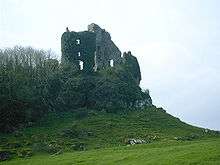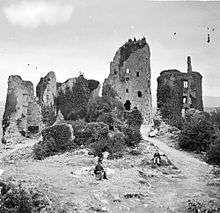Carrigogunnell

Carrigogunnell Castle is a medieval Irish fortification near the village of Clarina, on the banks of the River Shannon in Co. Limerick. Its location is Latitude: 52° 38' 48" N, Longitude: 8° 44' 33" W.
The buildings are of well cut limestone; the Keep is to the N. W. and is over 50 feet high, with 5 stories and a spiral stair it had a great circular bastion, perhaps older than the rest of the building, and a late (probably 16th century) house adjoins the east. A long range of older buildings (part being so strangely shattered by gunpowder that one staircase turret lies blown in one piece from its base) runs along the western flank of the rock. The lower court is rough and overgrown, with a hall at the N. E. Angle and a gate and sloping way to the south; the only other entrance is a small postern to the west.[1]

The place is first named in 1209, when Carrac Ui Conaing was granted to Donnchad Cairbreach, King of Thomond. No record remains for over a century; then a branch of the O'Briens seems to have crossed the Shannon, settled there, and overspread the old Norman Manor of Esclon, and southward, up the Maigue, their territory being represented by the barony and name of Pubblebrian; this is said to have been about 1336, but their chief's ancestor of the later Briens of Carrigogunnell, Tadhg na Glenore (O'Brien), was King of Thomond in 1426, and it seems doubtful whether his descendants obtained the place and built the castle much before 1450. The castle first appears in history in 1536; Leonard Grey, 1st Viscount Grane, the Lord Deputy, marched to "the very strong castle called Carekogunyel, and in English Candell Rock… It stands on a high rock and .... is the key of all the county."[1]
According to 1866 book, "Limerick; Its History and Antiquities, Ecclesiastical, Civil, and Military" By Maurice Lenihan states that other occupants of the castle were the O'Connell Family, who surrendered it to the Fitzgeralds. [2]
The owner, "Mat" (Mahon) O'Byrne, surrendered it on condition that the Government should hold it themselves. State pledges were broken as easily then as now. Grey was about to give it to one Donoth O'Bryne, ignoring his promise, when by a plot of Edmond Sexton and his wife (as their enemies alleged, but Grey acquitted them) it was put back into the hands of "Matthew's" warder; it was then attacked, and one of its towers was taken on the night of August, 22; the keep surrendered next morning, and Edmond Cahill, the warder, and all its garrison were brought to Limerick, tried and hanged. The Crown claimed the castle, apparently on the unfounded statement that the O'Briens held from "Lord Clerre", probably Richard De Clare, whose lands had reverted to the Crown. Donough was established in it, but he abused his powers and was deprived for extortion. Mahon used to claim a penny for each barrel of wine, and 2 pence for every other barrel brought to Limerick.[3]
The older name was used, about 1580, being Carrig Gunning in the valuable "Hardiman Map," 63, about that year, and Carykgonyn in Gerardus Mercator's map. Donough's son, Brian Duff, was confirmed in it and in nearly all the present Pubblebrian. A Captain Wilson took it over and built a stable there after it was prudently sold by its last owner, Donough Brien, to Michael Boyle (afterwards Archbishop of Dublin). It then had a castle, bawn, a few thatched huts, and a salmon fishery.[4]
During the second siege of Limerick of the Williamite War in Ireland, the castle was occupied by a force of 150 men for King James II. In August 1691 the Dutch general Godert de Ginckell sent Lieutenant-General Scravemore with a strong party, and four guns, to tak the castle. The garrison surrendered and were marched to Clonmel as prisoners of war. Shortly after, in September 1691, de Ginckell ordered Carrigogunnell slighted and it was blown up.[4][5][6]
A local legend tells of a death-dealing candle whose light after nightfall killed all that saw it. St Patrick, or one of Fionn Mac Cumhaill's warriors, Regan, scaled the rock, destroyed the light, and sprang away just in time from the irate sorceress of the candle. A late version made her hurl a huge rock (still called Clochregan) far to the south of the castle after the hero. Another made St Patrick pursue a demon bull to Adare, where he killed it at the Ford of Ath Tairbh.[4]
Notes
- 1 2 Westropp, p. 50
- ↑ Lenihan, pp.37
- ↑ Westropp, pp. 50,51
- 1 2 3 Westropp, pp.51
- ↑ James Frost, Part II. History of Thomond, Chapter 28, Footnote 27
- ↑ Shaw (1931), p. 1209-1227 facsimile of original p. 1211). Retrieved 2009-12-10. For the rank of Lieut. Gen. Scravemore.
References
- Westropp, Thomas Johnson, et al., (1916). The Antiques of Limerick and Its Neighbourhood, Figgis
- Westropp, T.J. 'et al.., (facsimile republished 2008) The Antiques of Limerick and Its Neighbourhood, READ BOOKS, ISBN 1-4097-8182-8, ISBN 978-1-4097-8182-0. pp. 50, 51
- Frost, James. The History and Topography of the County of Clare, The Journal of Thomas Dineley, 1681, website of County Clare Library. Retrieved 10 December 2009
- Shaw, William A. (editor, 1931) Calendar of Treasury Books, Volume 9, Institute of Historical Research, website of British History Online.
- Attribution
![]() This article incorporates text from a work in the public domain: "The Antiques of Limerick and Its Neighbourhood", by Westropp, T.J. et al., 1916
This article incorporates text from a work in the public domain: "The Antiques of Limerick and Its Neighbourhood", by Westropp, T.J. et al., 1916
Further reading
- Mac Neill, Tom, (1994). Castles in Ireland, Routeledge, p. 194.
- O'Connor, John, (1975). Carrigogunnell Castle, Dalton.
- Westropp, T.J., (1907). Carrigogunnell Castle and the O'Briens of Pubble-Brian in the County of Limerick, JRSAI 37,
- Westropp, T.J. et al., (1916). Illustrated Guide to the City of Limerick
| Wikimedia Commons has media related to Carrigogunnell Castle. |